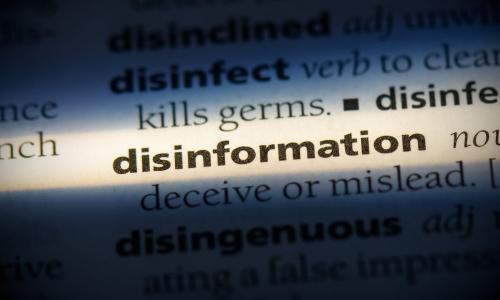The goal of disinformation is to confuse and manipulate the public; distract, divide, and demoralize communities; and control a narrative—all for financial, political, or ideological gain.
How to identify disinformation
So how can you help stop disinformation? The first step is knowing it when you see it.
If you come across a controversial claim—whether it’s online, in your mailbox, or in the media—ask yourself the following questions.
- Is it difficult to separate facts from opinions?
- Does it fail to cite experts from reputable organizations?
- Is the original source of the information hard to pin down?
- Does it confirm your beliefs, or play to your emotions?
- Does the group, person, or organization sharing the information have a stake in the claim (financial, political, or otherwise)?
- Does it require belief in a secret plot and a group of co-conspirators?
- Does it scapegoat people or groups?
- Is it spread by someone who recently started their social media account, but has a lot of followers?
If you answer “yes” to one or more of the questions, you may want to do further research to figure out who’s creating or pushing the information and whether they’re trying to manipulate you with lies or misleading information.
Whether the motivation is straightforward, such as profiting directly from untruths, or harder to discern–such as sowing division, doubt, or chaos–someone always benefits from disinformation.
Spotting unreliable sources
How can you tell if a source is reliable? For a news article, video, or social media post, ask yourself the following questions.
- Does it back up its statements with links to independent experts with relevant knowledge or references to peer-reviewed science?
- Does it fairly present differing points of view while acknowledging the importance of expertise?
- Does it treat individuals who have differing perspectives with respect?
- Does it distinguish facts from opinions?
- Is the content free from racial, gendered, ableist, anti-LGBTQ2S or otherwise problematic stereotypes?
- Does it make it easy to identify funding sources or ideological or policy positions?
If you answered “no” to one or more of the questions, think twice before you share their claims. Your next step is to check for credible sources.
Credible sources in science
Those who create disinformation often try to bolster their claims by citing reports or studies of dubious credibility.
When you encounter a reference to a scientific report or study, before you share the claim, ask yourself the following questions. If you answer “no” to one or more of the questions, you may have to do some research to evaluate the credibility of the report.
- Is the study peer-reviewed?
- Have the authors disclosed their conflicts of interest and funding sources? If yes, does the sponsor have a vested interest in the outcome of the study?
- Who produced the study? Are they unbiased toward a preexisting policy or ideological position on the topic?
- Is the tone objective?
- Does it describe potential positives and negatives in clear terms? Does it cite and critique conflicting findings?
- Have other scientists commented about the study? If yes, are they raising major concerns with how the study was conducted? And do these scientists have ties to political interest groups who may have a vested interest in the outcome of the study?
For more on how some use disinformation to manipulate science and scientists to distort the truth, check out our Disinformation Playbook.
OK. I’ve spotted disinformation. Now what?
If you think you’ve encountered disinformation, it’s crucial to understand how to effectively counter it. First, and most importantly, do not share or amplify it in any way, even if it’s to correct or debunk the false claim.
We want to stop disinformation in its tracks, not spread the disinformation further and help advance the goals of the bad actors behind it.
What should you do instead? Learn more about How to Stop Disinformation.
Learn more

How to Stop Disinformation

How Disinformation Works






